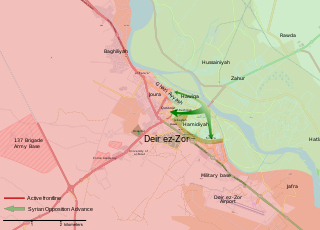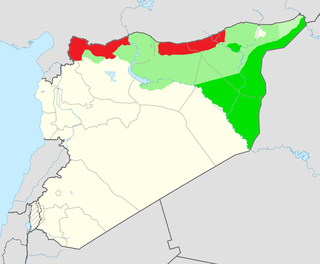
Protests against the Syrian government and violence had been ongoing in the Syrian city of Deir ez-Zor since March 2011, as part of the wider Syrian Civil War, but large-scale clashes started following a military operation in late July 2011 to secure the city of Deir ez-Zor. The rebels took over most of the province by late 2013, leaving only small pockets of government control around the city of Deir ez-Zor.

The 17th Reserve Division is a formation of the Syrian Army responsible for north-eastern Syria. It is one of two autonomous reserve divisions of the Syrian Arab Army, the other being the 18th Armoured Division. The 17th Division is part of the 3rd Corps.
The Deir ez-Zor offensive was executed by the Islamic State of Iraq and the Levant, also known as ISIS, against all other opposition forces in the Deir ez-Zor Governorate as part of the Inter-rebel conflict during the Syrian Civil War.

The Deir ez-Zor Governorate campaign of the Syrian civil war consists of several battles and offensives fought across the governorate of Syria:

The Lions of the East Army is a Syrian rebel group formerly affiliated with the Free Syrian Army's Southern Front that was formed in August 2014 and is based in southeastern Syria. Many of the group's fighters are al-Shaitat tribesmen from the Deir ez-Zor Governorate. The group was also active in Damascus city between January and July 2015, when its unit in Damascus merged into Jaysh al-Islam's 8th Brigade. It mainly focused on defeating the Islamic State of Iraq and the Levant in the eastern Syrian Desert, where it gained control over large areas since 2016.

The Army of Revolutionaries, also known as Jaysh al-Thuwar, is a multi-ethnic armed Syrian rebel coalition that is allied with the primarily Kurdish People's Protection Units (YPG) and participating in the Syrian Civil War as part of the Syrian Democratic Forces (SDF).

The Syrian Democratic Forces (SDF) is a Kurdish-led coalition formed by ethnic militias and rebel groups, and serves as the official military wing of the Autonomous Administration of North and East Syria (AANES). The SDF is allied to and supplied by the United States–led CJTF–OIR international alliance. Founded in 10 October 2015, the SDF claims that its mission is fighting to create a secular, democratic and federalized Syria. The SDF is opposed by Turkey, who claims the group has direct links to the PKK, which it regards as a terrorist group.

The Forces of the Brave, generally called the al-Sanadid Forces, are a militia formed by the Arab Shammar tribe to fight against the Islamic State. Even though the tribe's Syrian strongholds are mostly in the Jazira Canton of the Autonomous Administration of North and East Syria, such as at al-Yaarubiyah and Tell Hamis, the militia operates throughout most of the AANES. The red colour in their flag represents blood while the yellow represents the light, calling themselves “marchers on the red death”. The al-Sanadid Forces are affiliated with the co-governor/co-president of Jazira Canton and tribal leader Humaydi Daham al-Hadi, and are led by Humaydi's son Bandar al-Humaydi.
Liwa al-Quds or the Jerusalem Brigade is a predominantly Syrian Palestinian brigade that operates as a part of pro-Syrian government forces in the Syrian Civil War. Since 2019, it is part of the Syrian Army's 5th Assault Corps. It was formed in 2013 by the engineer Muhammad al-Sa'eed. The fighters who call themselves the 'Syrian Arab Army Fedayeen' are active in Aleppo and Daraa. The brigade is composed of Sunni Palestinians from the Neirab camp and Ein Al-Tal camp as well as reconciled rebels.

The Syrian Democratic Forces (SDF) has many military councils for local security and defense, each being accountable to the civil council of the area they operate in.
Fares Bayoush is a former lieutenant colonel in the Syrian Arab Air Force who defected to the Free Syrian Army in 2012.

The Northern Democratic Brigade is a Free Syrian Army unit that is closely allied to the Syrian Kurdish YPG and YPJ in Afrin Region since 2014. Led by Absi Taha, Alexander Khalil, and Alexander Alaa, it also joined the Syrian Democratic Forces (SDF) in November 2015. The initial members of the group originated from Jabal Zawiya in Idlib, and it has recruited Arabs from Idlib, Aleppo, and other cities in northern Syria since allying with the YPG. Since joining the SDF, the unit has begun to operate across much of northern and eastern Syria, participating in operations against anti-SDF Syrian opposition factions, the Islamic State of Iraq and the Levant, the Turkish Armed Forces, and the Syrian National Army.
The following is a timeline of the Syrian Civil War from September to December 2017. Information about aggregated casualty counts is found at Casualties of the Syrian Civil War.
Tajammu Ahrar al-Sharqiya, commonly referred to as Ahrar al-Sharqiya, is an active armed Syrian rebel group founded in 2016 by individuals exiled and displaced mostly from the Deir ez-Zor Governorate and other eastern provinces, such as the Hasakah Governorate, by ISIL, YPG and the Syrian government due to fighting that took place there between 2011 and 2014. Many fighters in Ahrar al-Sharqiya are former al-Nusra and Ahrar al-Sham members.

Osama Suleiman Mansour Hilali is a member of the Kurdish Future Movement in Syria. He was also an activist who led protests during the Syrian uprising in 2011, and a militant who founded the Mashaal Brigade, an armed rebel group that consisted of both Kurds and Arabs. Under Hilali's command, the group fought against Syrian government forces and the mainly-Kurdish People's Protection Units (YPG) between 2012 and 2013, during the Syrian Civil War, most notably in the Battle of Ras al-Ayn.
Opposition–ISIL conflict during the Syrian Civil War started after fighting erupted between Syrian opposition groups and the Islamic State of Iraq and the Levant (ISIL). In early January 2014, serious clashes between the groups erupted in the north of the country. Opposition groups near Aleppo attacked ISIL in two areas, Atarib and Anadan, which were both strongholds of the fundamentalist Sunni organization. Despite the conflict between ISIL and other rebels, one faction of ISIL has cooperated with the al-Nusra Front and the Green Battalion to combat Hezbollah in the Battle of Qalamoun. By 2018.

The Eastern Syria insurgency is an armed insurgency being waged by remnants of the Islamic State of Iraq and the Levant (ISIL) and both pro and anti-Syrian government Arab nationalist insurgents, against the Autonomous Administration of North and East Syria (AANES), its military, and their allies in the US-led Combined Joint Task Force – Operation Inherent Resolve (CJTF–OIR) coalition.

Rashid Abu Khawla, also known as Ahmed al-Khbeil, is a Syrian rebel leader who is a former commander in the Syrian Democratic Forces and former Syrian Opposition leader based in Deir ez-Zor.
The following is a timeline of the Syrian civil war for 2021. Information about aggregated casualty counts is found at Casualties of the Syrian civil war.
The following is a timeline of the Syrian civil war for 2022. Information about aggregated casualty counts is found in Casualties of the Syrian civil war.










